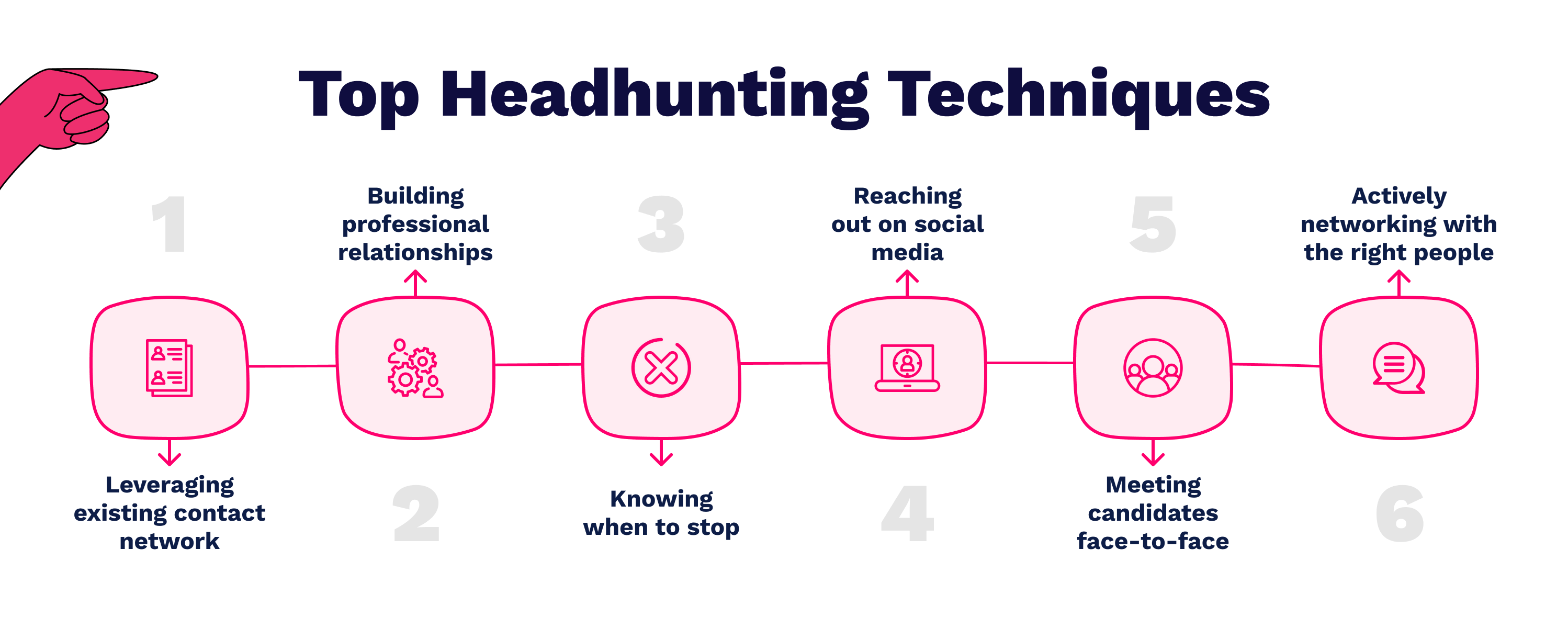Headhunting in Tech Recruitment: Pros and Cons, Tips, Techniques
Recruitment headhunting is the process of attracting a specific talent to ensure the lasting growth and strategic success of a business. If you are looking for the right person to fill a specific role or plan to attract crucial talent shortly, read on to gain in-depth insight into headhunting in recruitment.
Discover how it differs from the traditional tech hiring process, as we cover its pros and cons and provide tips on how to identify trustworthy headhunting recruitment agencies. You will then feel fully equipped to choose the right headhunting partner to conduct a productive executive recruitment search for your company.
What is headhunting in recruitment?
According to a definition from Investopedia, headhunting services include recruiting talent on behalf of a client via an individual or by a third-party tech recruitment agency. In contrast to standard recruitment, which is reactive and project-oriented, headhunting takes a more personalized approach to help companies achieve long-term objectives.
In the headhunting process, the hiring team, which often includes human resources and hiring managers, collaborates to craft a compelling job description that attracts suitable candidates. Headhunters go beyond relying solely on job boards and employ various tactics such as attending job fairs, leveraging networks, and utilizing industry contacts to identify potential candidates.
What's the difference between recruiters and headhunters?

When we compare headhunting to traditional recruitment, there are several significant differences. For one, recruiters open their search to the widest possible audience in the hope of finding a suitable candidate. In contrast, recruitment headhunters target the select few who they have decided are the most suitable candidates for the role. Let’s compare recruiters vs. headhunters on several other points:
- Recruiters try to find the best solution for both the company and the candidate. Headhunters aim to find the candidate who best corresponds with the profile required by the company.
- Recruiters always have a large pool of candidates and try to match them to the newly opened vacancies. Headhunters concentrate on the role requirements to ensure the best fit based on the job requirements.
- Recruiters only require basic knowledge of the technical qualifications of the role being filled. Headhunters must possess an in-depth understanding of the industry they operate in.
In short, recruiters implement a more general search with a broader reach. But if we speak of executive recruiting search professionals, they specialize in building and fostering long-term relations with a vast network of talents. As a result, the companies often employ headhunters to fill strategic and senior positions, while recruiters are responsible for multiple entry and middle-level jobs.
Related: Virtual Recruitment: Pros, Cons, Mistakes To Avoid

Top headhunting techniques
The headhunting hiring process has some notable differences when compared with standard recruitment. By increasing your understanding of headhunting best practices, you will be sure to choose the best headhunter for your needs.
Leveraging existing contact network
Headhunters rely on their network of professional and personal contacts when finding the best candidates. Even if there isn’t a perfect person among the headhunter’s acquaintances, a referral is always possible from within this network. This way, when the company opens the position, the headhunter can access the best person for the job.
Building professional relationships
Cultivating relationships with business leaders in different industries facilitates introductions to an even wider circle of contacts. Headhunters are engaged to identify the candidates who best suit the role on offer, and who may not yet be looking to change jobs.
Therefore, the headhunter must conduct in-depth research into the background of every potential candidate. This way, when a position becomes available that corresponds with a contact’s skills and experience, the headhunter can prepare a pitch to secure the candidate’s interest.
Knowing when to stop
The worst nightmare of any professional is a tiresome recruiter pestering them for months with a job offer they are absolutely not interested in. By staying in touch, good headhunters know the situation of the members of their networks:
- Does the current employer satisfy all the demands of the talent?
- Is the job rewarding and fulfilling?
- Is the company stable and well-funded (or on the brink of bankruptcy)?
This way, an experienced headhunter knows when to pursue a candidate and offer them a new opportunity or stop insisting to avoid souring the relationship.
Reaching out on social media

While LinkedIn is the backbone of the tech recruitment process, it is not the only platform potential candidates use. Many of them are active on Twitter, Instagram, and Facebook. A high-quality executive recruitment search involves reaching out to prospects on social media, commenting on their posts, and discussions on their preferred platform.
Meeting candidates face-to-face
To strengthen the bond, headhunters communicate with their contacts all the time and often not as part of the hiring process. Meetings after work or during lunch breaks form lasting connections. This might be time-consuming but increases the probability of a positive response when the time comes to make an offer.
Actively networking with the right people
By actively participating in conferences, hackathons, workshops, and other industry events, headhunters gain access to a treasure trove of valuable contacts and potential candidates. This approach allows them to establish meaningful connections with both active job seekers and passive candidates, increasing the chances of finding top talent for open positions.
All of these activities are essential for successful headhunters. But how can you tell if a headhunter is actually good?
What makes a good headhunter?
Headhunting is contingency recruitment, meaning only the specialist who provides the client with the right candidate gets paid 20-25% of their annual salary. Your best option is to work with an experienced tech recruitment agency that can get the job done and not waste the time of all the parties involved. What are the signs of a good recruitment headhunting professional, then?
Expertise in the job skills needed for their industry
Good headhunters have a strong background in the industry and can quickly evaluate if a candidate has the necessary skills and experience for the role.
Ability to spot hidden gems
Often, the best talents are unemployed just once in their professional lives, immediately after graduation. It’s worth keeping track of the best graduates and grabbing them as fast as you can. Headhunters stay across job fairs, internship programs, and other initiatives that provide a vast talent pool. Tech specialists rapidly grow as professionals and can become valuable additions to your team.
In-depth analysis of job profiles and quick skill assessment
Great headhunters are good amateur psychologists and can quite quickly form a profile of a person. This helps them easily assess each candidate and their suitability for the role on offer.
Great interpersonal skills
Top performers are rarely unemployed, so they often require more convincing when presented with a new, unexpected opportunity. A headhunter must be able to earn their trust and persuade them that this career move is in their best interests. This requires excellent soft skills and experience in negotiations.
Passion, persistence, and drive
Interestingly enough, salary is rarely the most decisive factor in headhunting. Top talents search for fulfilling and rewarding positions where they can make an impact and grow professionally, not just bigger paychecks. Thus, a headhunter must have a persistent art of persuasion to convince the prospect that the position on offer is exactly what they need.
Let’s now take a look at the benefits and shortcomings of headhunting in recruitment.
Read more: Outsourcing vs. In-House Recruitment: What to Choose?
What are the advantages and disadvantages of headhunting?
The table below lists all the crucial positive and negative aspects of recruitment headhunting.

How can you be sure to make the most of the advantages and avoid the downsides of an executive recruiting search? By working with a credible remote job recruitment agency! If you are looking to hire a team in Ukraine or find an outstanding C-level executive for your company — MagicHire has a proven record of headhunting services, and we are ready to lend a hand.
Conclusion
To wrap it up, with a clear understanding of headhunting and its relevance, you can tap into the vast pool of potential candidates and make informed decisions when selecting the right executive search partner. By leveraging the expertise of reputable headhunting agencies, you can maximize your chances of successfully filling open positions with exceptional talent, contributing to your company's long-term growth and strategic success.
MagicHire is among the leading headhunting recruitment agencies in Ukraine, and we can provide skilled recruitment headhunters to successfully fill all your open job roles with the best candidates. If you want to know more about how MagicHire can help find your next candidate, contact us!

FAQ
What is the headhunting method?
The headhunting method is a proactive approach in recruitment where specialized professionals, known as headhunters, actively seek out and target top candidates, often individuals in high-level or executive positions, for specific job openings.
How does headhunting differ from traditional hiring processes?
Headhunting seeks passive candidates, while traditional hiring targets active job seekers through job postings.
How can companies target specific job candidates through strategic headhunting?
Strategic headhunting allows companies to focus their efforts on specific job candidates, including chief executive officers (CEOs) and other executive-level professionals.
What role do human resources play in the recruiting and hiring process?
Human resources are responsible for managing the entire process, from attracting potential candidates to screening and selecting the best fit for open positions.






